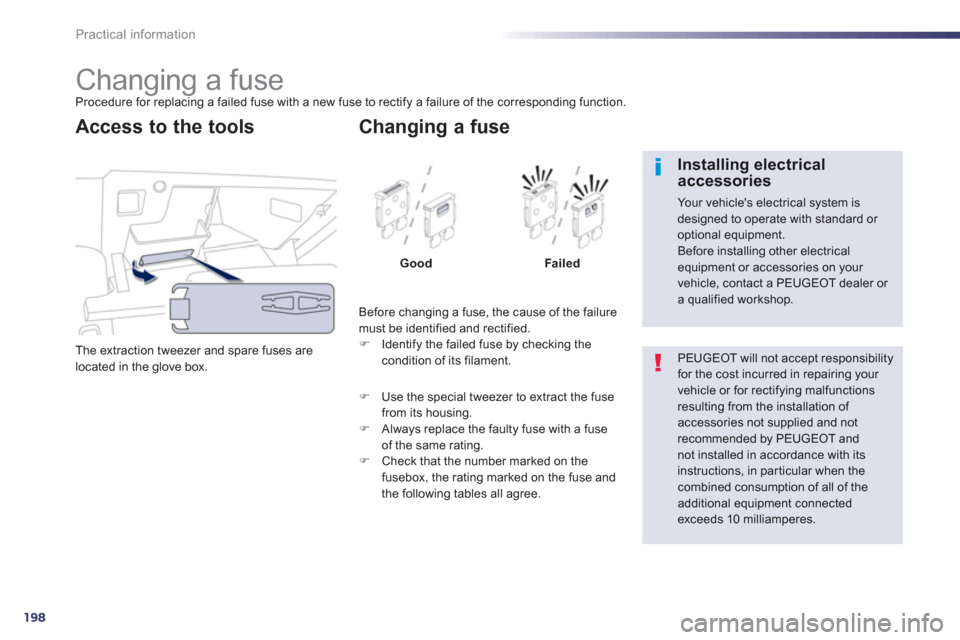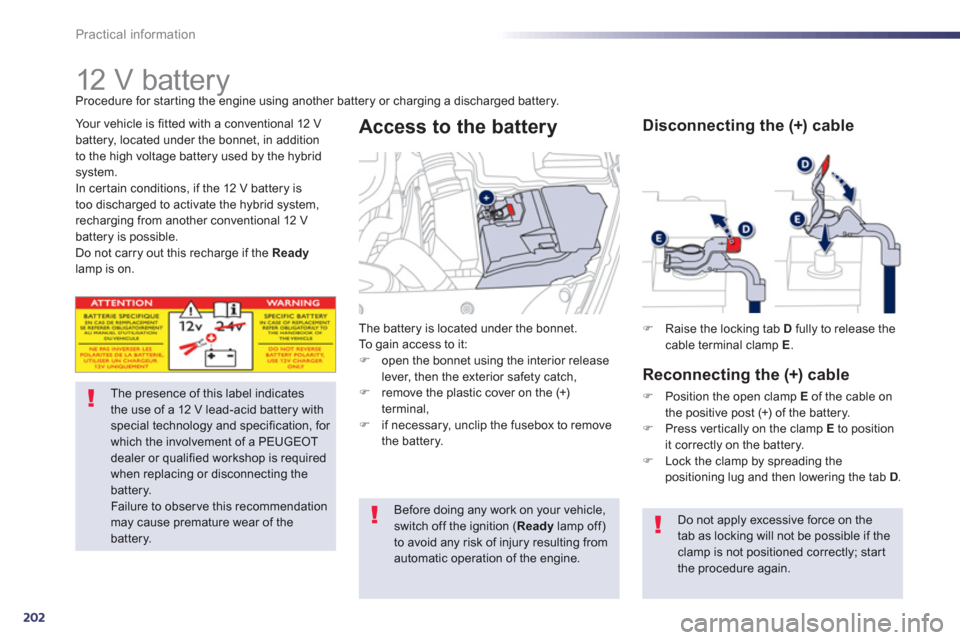Page 5 of 304
.
.
Contents
Child seats 158
ISOFIX child seats 164
Child lock 167
Child safety
Direction indicators 168
Emergency or assistance call 169
Horn 169
ESP system 170
Seat belts 173
Airbags 176
Safety
Te m p o r a ry puncture repair kit 180
Changing a wheel 186
Changing a bulb 191
Changing a fuse 198
12 V battery 202
Energy economy mode 205
Changing a wiper blade 206
Recovering the vehicle 207
Vehicle recovery 209
To w i ng a trailer 210
Fitting roof bars 212
Accessories 213
Practical information
Opening the bonnet 216
Running out of fuel (Diesel) 217
Diesel engine 218
Checking levels 219
Checks 222
Checks
Electric motor 225
Diesel engine 226
Diesel weights 227
Dimensions 228
Identifi cation markings 229
Technical data
Emergency or assistance 231
JBL equipment 233
Peugeot Connect Navigation (RT6) 235
Audio equipment and telematics
Alphabetical index
Visual search
Page 14 of 304

12
Familiarisation
11.Front door window demisting/defrostingvent.
12.Windscreen demisting/defrosting vent.
13
. Steering lock and star ting with the key. 14 .
Starting using the electronic key.
15. Audio equipment steering wheel controls.
16.Wiper / screenwash / trip computer stalk.
17. Central locking and hazard warningbuttons.
18. Screen.
19.Central adjustable air vents.
20.Passenger's airbag. 21. Side adjustable air vents.
Instruments and controls
1.
Cruise control / speed limiter controls. 2.
Headlamp height adjustment. 3.
Lighting and direction indicator stalk
4.
Instrument panel. 5.
Driver's airbag.Horn.
6.Gear selector.
7. HYbrid4 mode selector. 8.12 V accessory socket
USB por t / auxiliary socket. 9. Bonnet release lever.10.Fusebox.
22.
Glove box / Passenger's airbag deactivation. 23.
Electric parking brake.
24.
Central armrest with storage. 25.Storage (according to version).26.Audio system. 27.
Heating / air conditioning controls.28.
Alarm / Peugeot Connect SOS -
Peugeot Connect Assistance.29. Peugeot Connect Navigation (RT6)controls. 30.
Massage / Adaptive lighting / Parkingspace sensor.
Page 200 of 304

198
Practical information
Changing a fuse Procedure for replacing a failed fuse with a new fuse to rectify a failure of the corresponding function.
The extraction tweezer and s
pare fuses are
located in the glove box.
Access to the tools
Before changing a fuse, the cause of the failure
must be identified and rectified. �) Identify the failed fuse by checking thecondition of its filament.
Changing a fuse
Good Failed
�)
Use the special tweezer to extract the fuse from its housing.�)
Always replace the faulty fuse with a fuse of the same rating.�)
Check that the number marked on thefusebox, the rating marked on the fuse and
the following tables all agree.
PEUGEOT will not accept responsibilityfor the cost incurred in repairing your vehicle or for rectifying malfunctions resulting from the installation of accessories not supplied and notrecommended by PEUGEOT andnot installed in accordance with its instructions, in par ticular when thecombined consumption of all of the additional equipment connectedexceeds 10 milliamperes.
Installing electricalaccessories
Your vehicle's electrical system isdesigned to operate with standard or optional equipment.
Before installing other electrical equipment or accessories on your vehicle, contact a PEUGEOT dealer or a qualified workshop.
Page 201 of 304
8
199
Practical information
Access to the fuses
�)Open the glove box. �)Remove the plastic cover.
Fuse N°
Rating (A)
Functions
F6 A or B 15
Audio s
ystem.
F
83 Alarm.
F1
310 Front cigarette lighter.
F1410
Front 12 V socket.
F1
63 Rear courtesy lamp, rear map reading lamps.
F17
3 Front cour tesy lamp, cour tesy mirror.
F2
8 A or B15 Audio system.
F3
020 Rear wiper.
F32 10
Audio amplifier.
Page 202 of 304
200
Practical information
Dashboard fuses
The fusebox is placed in the lower dashboard (right-hand side).
Access to the fuses
�)Open the folding panel then apply pressure
to bypass the stops.
Fuse N°Rating (A)Functions
F
315 Driver's electric window panel, 12 V socket for rear seats.
F
415 12 V socket in boot.
F530 One-touch rear window.
F
630 One-touch front window.
F1
120
Trailer unit.
F12 20
Audio am
plifier.
F1
520
Panoramic sunroof blind (SW).
F1
65 Driver's electric window switch panel.
Page 203 of 304
8
201
Practical information
Engine compartment fusesFuse N°
Rating (A)
Functions
F20 15
Front / rear screenwash pump.
F2
120 Headlamp wash pump.
F2215 Horn.
F2
315 Right-hand main beam headlamp.
F2
415 Left-hand main beam headlamp.
F27 5
Le
ft hand lamp mask.
F2
85 Right hand lamp mask. The fusebox is placed in the engine compartment near the battery.
Access to the fuses
�)Unclip the cover. �)Change the fuse (see corresponding paragraph).�)When you have finished, close the cover carefully to ensure correct sealing of thefusebox.
Page 204 of 304

202
Practical information
12 V battery
The presence of this label indicatesthe use of a 12 V lead-acid battery withspecial technology and specification, for which the involvement of a PEUGEOT dealer or qualified workshop is requiredwhen replacing or disconnecting thebattery.
Failure to observe this recommendation may cause premature wear of thebattery.
The battery is located under the bonnet.
To gain access to it:
�)
open the bonnet using the interior releaselever, then the exterior safety catch, �)
remove the plastic cover on the (+)
terminal,�) if necessary, unclip the fusebox to remove
the battery.
Access to the battery
Before doing any work on your vehicle,switch off the ignition ( Ready
lamp off)to avoid any risk of injury resulting fromautomatic operation of the engine. Y
our vehicle is fitted with a conventional 12 V
battery, located under the bonnet, in addition
to the high voltage battery used by the hybrid system.
In cer tain conditions, if the 12 V battery is
too discharged to activate the hybrid system, recharging from another conventional 12 V
battery is possible.
Do not carry out this recharge if the Readylamp is on. Procedure for star tin
g the engine using another battery or charging a discharged battery.
�)Raise the locking tab Dfully to release the cable terminal clamp E.
Disconnecting the (+) cable
Reconnectin
g the (+) cable
�)Position the open clamp Eof the cable on
the positive post (+) of the battery. �)Press ver tically on the clamp E
to position
it correctly on the battery. �)Lock the clamp by spreading the positioning lug and then lowering the tab D.
Do not apply excessive force on thetab as locking will not be possible if the clamp is not positioned correctly; star tthe procedure again.
Page 216 of 304

214
Practical information
The fitting of electrical equipmentor accessories which are notrecommended by PEUGEOT may result in a failure of your vehicle's electronic system and excessive electrical consumption.Please note this precaution. Youare advised to contact a PEUGEOTrepresentative to be shown the rangeof recommended equipment andaccessories.
Installation of radio communication transmitters
Before installing any after-market radiocommunication transmitter, you can contact a PEUGEOT dealer for thespecification of transmitters which can be fitted (frequency, maximum power, aerial position, specific installation
requirements), in line with the Vehicle Electromagnetic Compatibility Directive (2004/10 4/EC).
Depending on the legislation in force in the country, it may be compulsoryto have a high visibility safety vest,warning triangle and spare bulbs andfuses available in the vehicle.
You can also obtain products
for cleaning and
maintenance (exterior and interior) and toppingup fluids (screenwash, ...), as well as refills(cartridge for temporary tyre repair kit...) fromPEUGEOT dealers.
"Multimedia":
audio systems, portable navigation system,
Ta k a r a / S o ny por table video screen, Bluetooth system, speakers, DVD player, Wi-Fi, drivingaids, video suppor t, microwave unit...